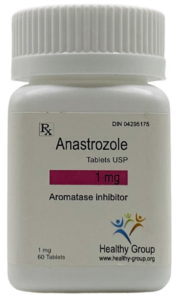Anastrozole Tablet, USP
DIN 04295175
1 mg
60 tablets, Square container

DESCRIPTION Anastrozole, is a non-steroidal aromatase-inhibiting drug approved for the treatment of breast cancer after surgery, as well as for metastasis in both pre and post-menopausal women. Anastrozole works by inhibiting the synthesis of estrogen. In Bodybuilding, Anastrozole is the aromatase inhibitor of choice. The drug is appropriately used when taking a substantial amount of aromatizing steroids, or when one is prone to gynecomastia and using moderate amounts of such steroids. Anastrozole does not have the side effects of aminoglutethimide and can achieve a high degree of estrogen blockade.
COMPOSITION Each tablet contains: Medicinal ingredients. Anastrozole 1 mg Non-medicinal ingredients. Microcrystalline cellulose, calcium carbonate, steric acid, magnesium stearate.
CLINICAL PHARMACOLOGY Anastrozole binds reversibly to the aromatase enzyme through competitive inhibition, inhibiting the conversion of androgens to estrogens in peripheral tissues (extra-gonadal).
Pharmacokinetics
Absorption Inhibition of aromatase activity is primarily due to anastrozole, the parent drug. Absorption of anastrozole is rapid and maximum plasma concentrations typically occur within 2 hours of dosing under fasted conditions. Studies with radiolabeled drug have demonstrated that orally administered anastrozole is well absorbed into the systemic circulation. Food reduces the rate but not the overall extent of anastrozole absorption. The mean C max of anastrozole decreased by 16% and the median Tmax was delayed from 2 to 5 hours when anastrozole was administered 30 minutes after food. The pharmacokinetics of anastrozole are linear over the dose range of 1 to 20 mg, and do not change with repeated dosing. The pharmacokinetics of anastrozole were similar in patients and healthy volunteers.
Distribution Steady-state plasma levels are approximately 3-to 4-fold higher than levels observed after a single dose of Anastrozole. Plasma concentrations approach steady-state levels at about 7 days of once daily dosing. Anastrozole is 40% bound to plasma proteins in the therapeutic range.
Metabolism Metabolism of anastrozole occurs by N-dealkylation, hydroxylation and glucuronidation. Three metabolites of anastrozole (triazole, a glucuronide conjugate of hydroxy-anastrozole, and a glucuronide conjugate of anastrozole it self) have been identified in human plasma and urine. The major circulating metabolite of anastrozole, triazole, lacks pharmacologic activity.
Anastrozole inhibited reactions catalyzed by cytochrome P450 1A2, 2C8/9, and 3A4 in vitro with Ki values, which were approximately 30 times higher than the mean steady-state Cmax values observed following a 1 mg daily dose. Anastrozole had no inhibitory effect on reactions catalyzed by cytochrome P450 2A6 or 2D6 in vitro. Administration of a single 30 mg/kg or multiple 10 mg/kg doses of anastrozole to healthy subjects had no effect on the clearance of antipyrine or urinary recovery of antipyrine metabolites.
Mechanism Of Action The growth of many breast cancers is stimulated or maintained by estrogens. In postmenopausal women, estrogens are mainly derived from the action of the aromatase enzyme, which converts adrenal androgens (primarily androstenedione and testosterone) to estrone and estradiol. The suppression of estrogen biosynthesis in peripheral tissues and in the cancer tissue itself can therefore be achieved by specifically inhibiting the aromatase enzyme.
Anastrozole is a selective non-steroidal aromatase inhibitor. It significantly lowers serum estradiol concentrations and has no detectable effect on formation of adrenal corticosteroids or aldosterone.
INDICATIONS Treatment of certain types of breast cancer in women who have been through menopause, including women with disease progression after tamoxifen therapy.
CONTRAINDICATIONS Anastrozole may cause fetal harm when administered to a pregnant woman and offers no clinical benefit to premenopausal women with breast cancer. Anastrozole is contraindicated in women who are or may become pregnant. There are no adequate and well-controlled studies in pregnant women using anastrozole. If anastrozole is used during pregnancy, or if the patient becomes pregnant while taking this drug, the patient should be apprised of the potential hazard to the fetus or the potential risk for loss of the pregnancy.
ADVERSE REACTIONS Bone weakness has been associated with anastrozole. Women who switched to anastrozole after two years on tamoxifen reported twice as many fractures as those who continued to take tamoxifen (2.1% compared to 1%). Bisphosphonates are sometimes prescribed to prevent the osteoporosis induced by aromatase inhibitors. The level of circulating estradiol is likely causal here and not the anastrozole itself, and so the dose will determine the likelihood of osteoporosis (estradiol inhibits osteoclasts, which resorb bone). It is possible to reduce too much estrogen with Anastrozole, and for this reason, blood tests, or less preferably salivary tests, should be taken after the first week of use to determine if the dosage is correct.
STORAGE INSTRUCTIONS Store anastrozole at room temperature, between 15-30 degrees Celsius (59° to 86° F), in a tightly closed, light-resistant container. Keep out of reach of children.
